The Economics and Statistics Division maintains archives of previous publications for accountability purposes, but makes no updates to keep these documents current with the latest data revisions from Statistics Canada. As a result, information in older documents may not be accurate. Please exercise caution when referring to older documents. For the latest information and historical data, please contact the individual listed to the right.
<--- Return to Archive
For additional information relating to this article, please contact:
October 02, 2020CORE HOUSING NEED, 2018 Statistics Canada has released new data on core housing need in Canada. The results come from the 2018 Canadian Housing Survey, conducted in cooperation with the Canada Mortgage and Housing Corporation. The data were collected from November 2018 to March 2019.
Definition of Core Housing Need
Statistics Canada defines 'core housing need' in 2 stages. The first stage considers whether a household lives in a dwelling that is unsuitable (insufficient rooms for family size), inadequate (in need of major repairs) or unaffordable (costs >30% of before-tax income); core housing need could be based on one or more of the three criteria. The second stage considers whether the household could access suitable, adequate and affordable housing in their community, given the household's income and current prices. Some households are excluded from evaluation of core housing need, including farm households, those living on reserve and non-family households aged 15-29 that are in education.
In Nova Scotia, 11.4% of households (45,100 households) were identified as being in core housing need in 2018. This compares with 11.6% of all Canadian households across the country. Core housing need was most prevalent in British Columbia and Ontario. The populations of Quebec and New Brunswick had the lowest share in core housing need.
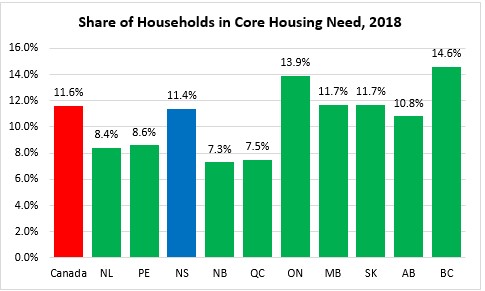
Halifax accounted for 24,200 (53.7%) of the households in core housing need in Nova Scotia. There were 5,700 Halifax owner households in core housing need (37.5 per cent of all Nova Scotian owner households in core housing need) and 18,500 Halifax renter households in core housing need (61.9% of all Nova Scotian renter households in core housing need).
Affordability is - by a wide margin - the leading cause of core housing need in Canada, accounting in whole or in part for 89% of the population identified as being in core housing need across the country. Affordability is somewhat less important (though still over 80%) in core housing need in New Brunswick, Manitoba and Saskatchewan.
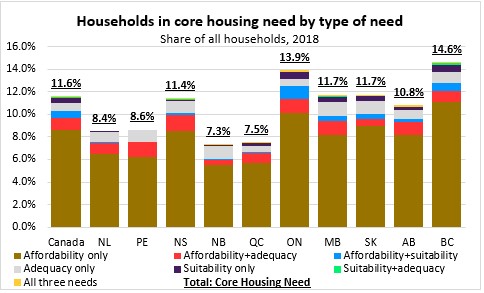
Core housing need is more prevalent among renters. Among Nova Scotia households that rent, 24% were in core housing need (29,900 households). Nationally, 23% of renter households were in core housing need. Core housing need among renters was higher in British Columbia, Ontario, Manitoba, Saskatchewan and Newfoundland and Labrador. The lowest share of renters in core housing need was reported in Prince Edward Island.
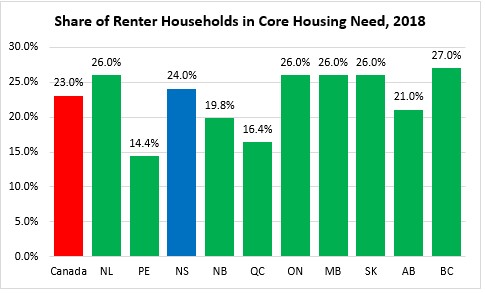
Among owner households in Nova Scotia, 5.6% were in core housing need in 2018 (15,200 households). This is below the national average of 6.5% of owner households in core housing need. Core housing need among owners was higher in British Columbia and Ontario. There was lower core housing need among owners in Quebec and New Brunswick.
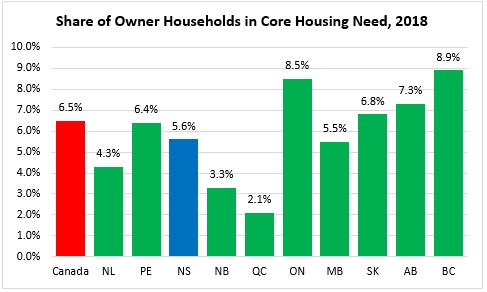
The composition of those in core housing need is primarily made up of non-subsidized renters and home owners who have not recently purchased their first homes. These are also the largest groups of households. Although subsidized renters and first-time home owners report higher prevalence of core housing need, these are also smaller populations. In Nova Scotia, 1,500 of the 15,200 owner households in core housing need were classified as first time home buyers. Of the 29,900 renter households in core housing need in Nova Scotia, 7,000 lived in designated social and affordable housing.
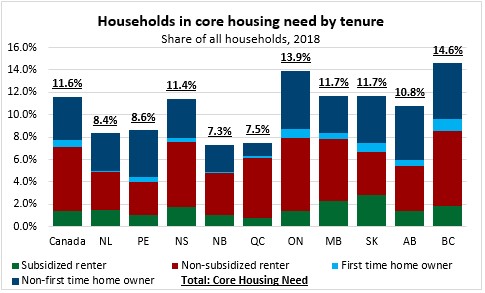
Core housing need is higher in larger urban centres. In 2018, 15.5% of Nova Scotian households in large urban centres were in core housing need, compared with a national average of 13.4%. Core housing need was highest in the large urban centres of British Columbia and Ontario and lowest in Quebec, Newfoundland and Labrador and New Brunswick.
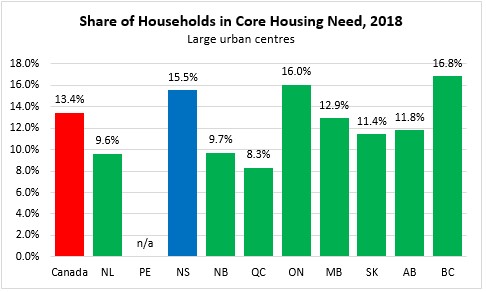
(Prince Edward Island does not have any communities that meet the definition of 'large urban centre').
In medium-sized population centres, 10.2% of Canadian households were in core housing need. Core housing need was higher in the medium population centres of Saskatchewan and British Columbia.

(Neither Nova Scotia nor Newfoundland and Labrador have any communities that meet the definition of 'medium population centre')
In smaller-sized population centres, 12.6% of Nova Scotian households were in core housing need - the highest share among all provinces. Nationally, 9.0% of households in small population centres were in core housing need. The prevalence of core housing need in small population centres was lowest in Quebec, New Brunswick and Prince Edward Island.
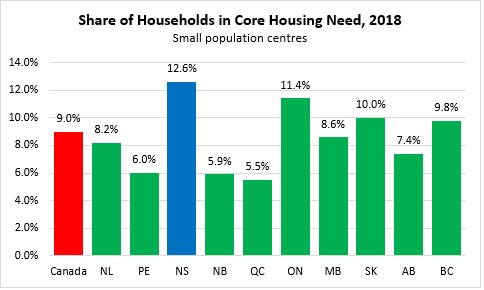
Core housing need is lower in rural areas of most provinces, except Prince Edward Island, Alberta and Saskatchewan, where core housing needs were higher in rural areas than the provincial averages. In Nova Scotia, 7.2% of rural households were in core housing need in 2018. Nationally, 7.6% of households were in core housing need in 2018. The lowest prevalence of core housing need among rural households was reported in Quebec and New Brunswick.

Large urban centres make up the bulk of Canada's population in core housing need. This is notably the case in Canada's more urban provinces: British Columbia, Ontario, Alberta and Quebec. With larger shares of the population living in rural areas, households in rural areas make up a larger share of core housing need in all Atlantic provinces as well as in Manitoba and Saskatchewan. Households in small population centres make up a larger share of the total population in core housing need in Nova Scotia, Newfoundland and Labrador and Saskatchewan.
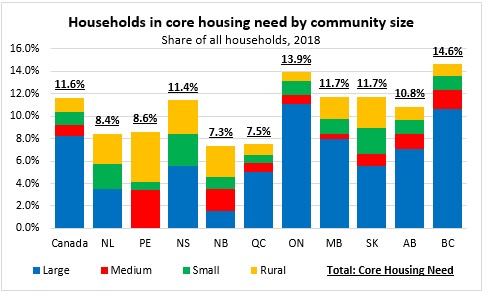
Sources
Statistics Canada. Table 46-10-0037-01 Dimensions of core housing need, by tenure including first-time homebuyer and social and affordable housing status; Table 46-10-0056-01 Core housing need, by tenure including first-time homebuyer and social and affordable housing status
<--- Return to Archive